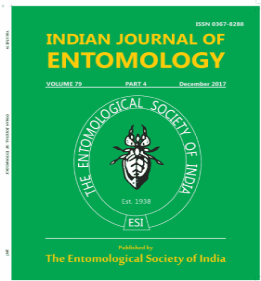Effect of Rearing Season on Queen and the Reproduction of Apis mellifera carnica and A mellifera ligustica
DOI:
https://doi.org/10.55446/IJE.2023.885Keywords:
Apis mellifera carnica, A. mellifera ligustica, queen, reproductive characters, spermatheca, sperm quantity, spermatozoaAbstract
Hybrids of Apis mellifera carnica and Apis mellifera ligustica queen bees were reared to investigate their physiological and reproductive characters as well as spermatheca semen volume to determine the suitable time for queen rearing under Giza conditions in Egypt. Rearing seasons were found to affect the queens’ quality determined based on their weight/ volume of the spermatheca, and quantity and quality of stored sperms in the spermatheca. Results indicated that the Carniolian hybrid gynes were heavier than Italian hybrid ones, with greatest mating success being observed in March and April, while it was worst during June. Spermatheca was less voluminuos with less spermatozoa in Italian hybrid queen bees compared to the Carniolian hybrid ones. Thus, under Giza region conditions, t is highly recommended to rear queens during the spring months.
Downloads
Metrics
Downloads
Published
How to Cite
Issue
Section
References
Adham M, 2000. Influence of some supplemental feeding on physiological characters and productivity of honey bees. Assiut University Bulletin for Environmental Researches., p.159.
Ahmet G, Hakan T, 2013. Relationship between dead pupa removals and season and productivity of honey bee (Apis mellifera, Hymenoptera: Apidae) colonies. Turkish Journal of Veterinary and Animal Sciences 37: 462-467.
Akyol E, Yeninar H, Korkmaz A, Çakmak I, 2008. An observation study on the effects of queen age on some characteristics of honey bee colonies. Italian Journal of Animal Sciences 7(1): 19-25.
Amiri E, Strand M K, Rueppell O, Tarpy D R, 2017. Queen quality and the impact of honey bee diseases on queen health: Potential for interactions between two major threats to colony health. Insects 8: 48-66.
Cengiz, M, Yazici, K, Arslan, S, 2019. The effect of the supplemental feeding of queen rearing colonies on the reproductive characteristics of queen bees (Apis mellifera L.) Reared from egg and different old of larvae. Kafkas Universitesi Veteriner Fakultesi Dergisi 25: 849-855.
Chuda-Mickiewicz B, Samborski J, 2015. The quality of honey bee queens from queen cells incubated at different temperatures. Acta Scintiarun Polonorum Zootechnica 14(4): 25-32.
Czekonska K, 2000. The influence of Nosema apis on younghoneybee queens and transmission of the disease from queens to workers. Apidologie 31: 71-706.
da Silva E C A, da Silva R M B, Chaud-Netto J, Moreti ACCC, Otsuk IP,1995. Influence of management and environmental factors on mating success of Africanized queen honey bees. Journal of Apiculture Research 34(3): 169 -175.
Delaney D A, Keller J J, Caren J R, Tarpy D R, 2011. The physical insemination and reproductive quality of honey bee queens (Apis Mellifera L.). Apidologie 42: 1-13.
Elenany Y E, Abdallah A E, 2016. Rearing honeybee queens in, Apis mellifera L. colonies during the activity season of oriental wasps Vespa orientalis L. Journal of Agricultural Technology 12(4): 667-674.
Güler A, Korkmaz A, Kaftanoglu O, 1999. Reproductive characteristics of Turkish honeybee (Apis mellifera L.) genotypes. Hayvansal Üretim 39(40): 113-119.
Guzmán-Novova E, Ropert E, Pag JR, Prieto-Merlos D, 1998. Queen introduction acceptenance and survival in honey bee (Hymenoptera: Apidae) colonies of a tropical Africanizedregion. Journal of Economic Entomolgy 91: 1290 -1294.
Harris JL, 2009. Development of honey bee colonies on the Northern Great Plains of North America during confinement to winter quarters. Journal of Apiculture Research 48(2): 85-90.
Hellmich R L, Danka R G, Rinderer T E, Collins A M, 1986. Comparison of Africanized and European queen-mating coloniesin Venezuela. Apidologie 17: 217-226.
John W R, Spooner-Hart S R, Anderson D L, Wheen G, 2011. Effects of age, season and genetics on semen and sperm production in Apis mellifera drones. Apidologie 42: 29-38.
Kaftanoglu O, Peng Y S, 1982. Effect of insemination on theinitiation of oviposition in the queen honeybee. Journal of Apiculture Research 21(1): 3-6.
Kaftanoglu O, Kumova Y S, 1992. Çukurova Bölgesi kotullarindaana ari yetittirme mevsiminin ana arilarin kalitesine olanetkileri (TUBITAK Doga). Turkish Journal of Veterinary and Animal Sciences 16: 569-577.
Koeniger G, Ruttner F, 1989. Mating behavior and anatomy of the reproductive organs. In: Moritz, R.F.A., (ed.). The Instrumental Insemination of the Queen Bee. Apimondia, Bucharest. pp. 28-30.
Koywiwattrakul P, Sittipraneed S, 2009. Expression of vitellogenin and transferrin in activated ovaries of worker honey bees, Apis mellifera. Biochemistry and Molecular Biology Education 47: 19-26.
Kulhanek, K., Steinhauer, N., Rennich, K., Caron, D.M., Sagili, R.R., Pettis, J.S., Ellis, J.D., Wilson, M.E., Wilkes, J.T., Tarpy, D.R., 2017. A national survey of managed honey bee 2015-2016 annual colony losses in the USA. Journal of Apiculture Research 56: 328-340.
Moretto G, Guerra J C V, Kalvelage H, Espindola E, 2004. Maternal influence on the acceptance of virgin queens introduced into Africanized honeybee (Apis mellifera) colonies. Genetics and Molecular Research 3(3): 441-445.
Rangel J, Keller J J, Tarpy D R, 2013. The effects of honey bee (Apis mellifera L.) queen reproductive potential on colony growth. Insect Society 60(1): 65-73.
Ruttner H, 1983. Maintaining queens during the mating period. In: Ruttner F. (ed.). Queen Rearing Biological Basis and Technical Instructions. Apimondia Publishing House, Bucharest. pp. 235-277.
Sakla R S S, El-shafeiy S N, 2022. Evaluation of royal jelly quality and queens production by using natural food supplements in honeybee colonies. Egypt. Journal of Agriculture Research 100(4): 458-466.
Stankus T A, 2008. Review and bibliography of the literature of honey bee colony collapse disorder: A poorly understood epidemic that clearly threatens the successful pollination of billions of dollars of crops in America. Journal of Agriculture and Information 9: 115-143.
Szabo TI, 1977. Relationship between weight of honeybee queens.(Apis mellifera) at emergence and cessation of egg laying. American Bee Journal 113: 250-251.
Szabo T T, Heikel D T, Mills P F, 1987. Effects of honeybee queen weight and air temperature on the initiation of oviposition. Journal of Apiculture Research 26(2): 73-78.
Taha E A, 2005. Studies on honeybee (Apis mellifera L.) Unpublished Ph.D. Thesis, Faculty of Agriculture Tanta Univ. Egypt. p.151. Taranov G F, 1973. Weight of queens and their quality. Pch-elovodsto (in Russian) 92: 27-29.
Wei H, He X J, Liao C H, Wu X B, Jiang W J, Zhang B, Zhou L B, Zhang L Z, Barron A B, Zeng Z J, 2019. A maternal effect on queen production in honeybees. Current Biology 29: 2208-2213.
Woyke J, Jasinki Z, 1973. Influence of external conditions on the number of spermatozoa entering the spermatheca of instrumentally inseminated honeybee queen. Journal of Apiculture Research 12(13): 145-151.
Woyke J, 1979. Effect of the Access of Worker Honeybees to the Queen on the Results of Instrumental Insemination. Journal of Apiculture Research 18(2): 136-143.
Yi Y, Liu Y B, Barron A B, Zeng Z J, 2020. Effects of commercial queen rearing methods on queen fecundity and genome methylation. Apidologie 52: 282-291.
Zedan E W M, 2002. Studies on Some Factors Affecting of Production Quality of Honeybee Queens at Giza Region. Assiut University Bulletin Environment Research. p. 134.
















